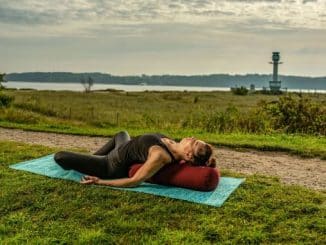
Shoulder pain [¹] is considered the third most common muscle and bone issue after pain in the lower back and knees.
And it is still prevalent among workers over 50 [²] and tends to rise in jobs that require a lot of physical effort.
Why Does My Shoulder Hurt?

Shoulder pain be attributed to various conditions, injuries, or overuse of the shoulder joint. Here are four common causes of shoulder pain:
1. Rotator Cuff Injuries
The rotator cuff [³] is a group of muscles and tendons that stabilize the shoulder joint. Injuries to the rotator cuff, such as tears or inflammation (tendinitis), are common causes of shoulder pain. Repetitive overhead motions, aging, or traumatic injuries can contribute to rotator cuff problems.
2. Frozen Shoulder (Adhesive Capsulitis)
A frozen shoulder is characterized by the gradual onset of pain and stiffness in the shoulder joint. The condition often limits the range of motion [⁴], making it difficult to move the arm. It can result from inflammation, shoulder immobility, or other underlying medical conditions.
3. Shoulder Impingement Syndrome
This condition occurs when the tendons of the rotator cuff become compressed or irritated as they pass through the narrow space between the acromion (a bony projection of the scapula) and the humerus (upper arm bone). Shoulder impingement can lead to pain, weakness, and difficulty raising the arm. [⁵]
4. Osteoarthritis
Osteoarthritis is a degenerative joint condition that can affect the shoulder. It involves the gradual breakdown of the cartilage that covers the ends of the bones in the joint. This can lead to pain, stiffness, and reduced range of motion [⁶] in the shoulder.
It’s important to note that other conditions, such as bursitis, tendinitis, dislocations, and fractures, can cause shoulder pain. Additionally, systemic conditions like heart or gallbladder issues can refer to pain in the shoulder area.
Take note: If you or someone you know is experiencing shoulder pain, it’s important to seek medical advice. Shoulder pain can be a symptom of various conditions and significantly impact quality of life.
Knowing how shoulder pain can nag at your daily activities, why is it important to have well-developed shoulder muscles?
Benefits of a Well-Developed Shoulder Muscles

Here are the common benefits of having well-developed shoulder muscles:
1. Increased Upper Body Strength
Well-developed shoulder muscles contribute significantly to overall upper body strength, enabling you to perform activities that involve lifting, pushing, and carrying with greater ease.
2. Improved Range of Motion
Strong and flexible shoulder muscles enhance your ability to move your arms through a broader range of motion, which is crucial for everyday activities and athletic performance.
3. Reduced Risk of Injuries
A well-balanced and strong shoulder musculature helps stabilize the shoulder joint, decreasing the risk of injuries such as strains and tears, especially in the rotator cuff area.
4. Enhanced Aesthetic Appearance
Well-developed shoulders contribute to a balanced and aesthetically pleasing physique, creating a broader upper body appearance and improving overall body symmetry.
It’s important to note that a comprehensive and balanced approach to shoulder development, including both strength and flexibility exercises, is key to reaping these benefits and preventing imbalances or overuse injuries.
5 Best Shoulder Workout Routine
A well-rounded shoulder workout routine targets various core muscles of the shoulder complex, including the deltoids and the rotator cuff. Here’s an effective and balanced shoulder workout routine:
1. Modified Plank to Child’s Pose
Begin in a 4-point position on the floor with your knees below your hips and your hands beneath your shoulders, maintaining good alignment of your head, shoulder, hips, and legs. Engage your core and shift your hips back to rest your seat on your feet. Lower your chest to the floor, extending your arms overhead. Hold this position for several deep belly breaths and raise back up to move into a modified plank position from the knees. Return to the starting position and repeat the movement as needed.
 | 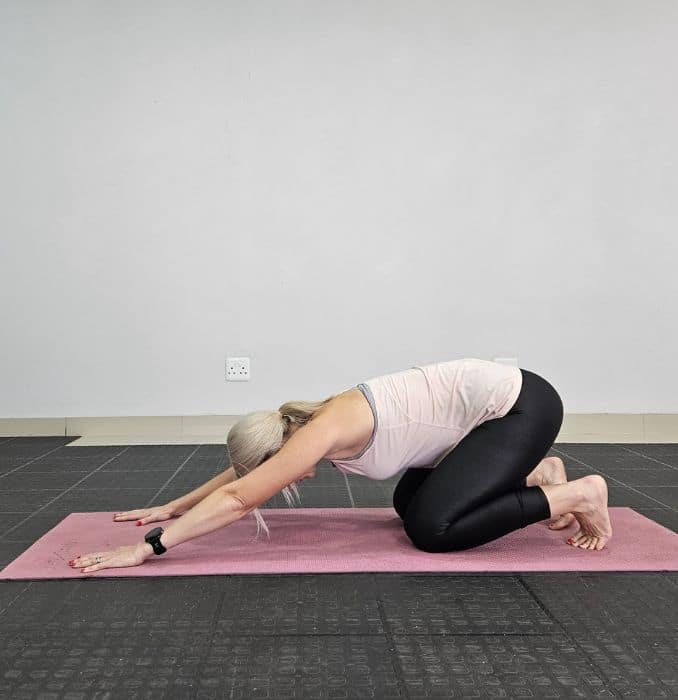 |
Pros:
- Strengthens core and shoulder stability
- Stretches spine, shoulders, and chest
- Promotes relaxation and stress relief
- Accessible for beginners.
Cons:
- Requires wrist strength and flexibility
- Potential for neck strain
- May lack challenge for advanced athletes
- Not suitable for those with certain injuries
- Limited muscle activation
2. Table Top Rock
Begin in a 4-point position on the floor with your knees below your hips and your hands beneath your shoulders, maintaining good alignmen of your head, shoulder, and hips. Engage your core and create a rocking motion by swaying your upper body from side to side. After several repetitions, return to the starting position. Repeat the movement as needed.
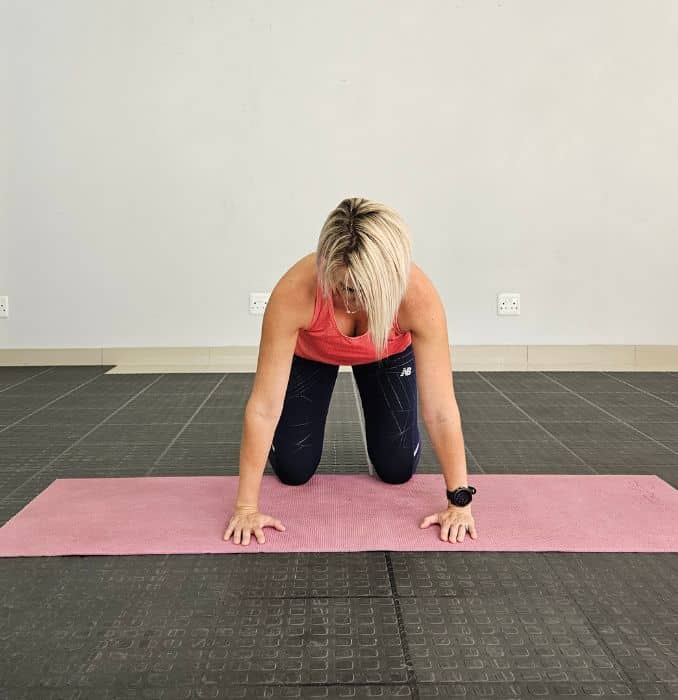 |  |  |
Pros:
- Improves core strength and stability
- Engages and strengthens the muscles of the upper body, including shoulders, arms, and chest
- Enhances coordination and balance
- Can help relieve tension in the spine and promote flexibility
- Accessible for beginners and can be modified for different fitness levels
Cons:
- Requires wrist strength and flexibility, which may be challenging for some individuals
- Potential for strain or discomfort in the wrists if proper form is not maintained
- May not provide sufficient challenge for advanced athletes seeking intense workouts
- Not suitable for individuals with wrist or shoulder injuries
- Limited muscle activation compared to more dynamic exercise
3. Seated Shoulder Rolls
Begin in an upright sitting position on a chair, maintaining good alignment with your head, shoulders, and hips. Place your hands on your lap. Engage your core. Lift your shoulders, then roll them down and back until you feel resistance in your shoulder blades. After several movements, lower your shoulders to the starting position, and repeat the movement in the opposite direction.
For added challenge, you can roll your shoulders in alternating directions, or shrug from side to side.
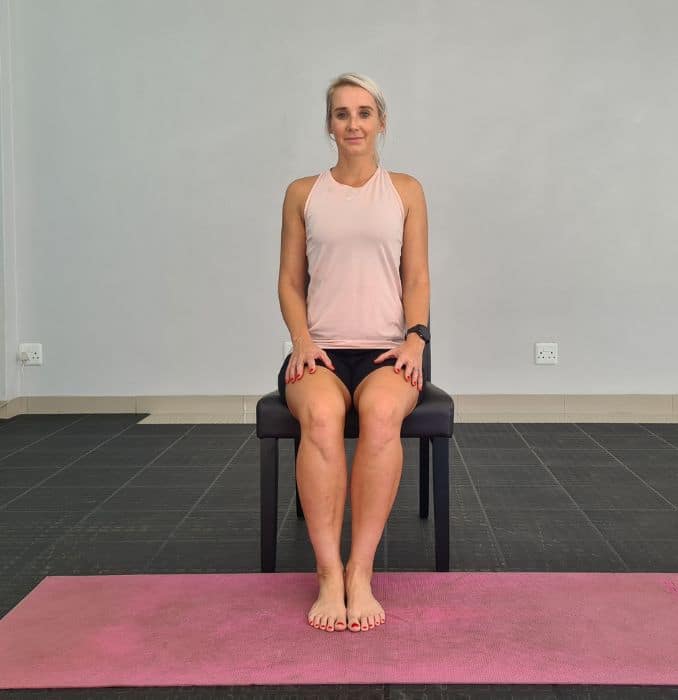 |  |  |
Pros:
- Helps improve shoulder mobility and flexibility
- Can relieve tension and stiffness in the shoulders and upper back
- Promotes better posture by strengthening the muscles that support the shoulder blades
- Can be done anywhere, anytime, without the need for equipment
- Simple and gentle exercise suitable for all fitness levels
Cons:
- Limited in terms of muscle activation compared to more dynamic shoulder exercises
- May not provide a significant challenge for those seeking strength gains
- Requires proper technique to avoid strain or discomfort in the neck or shoulders
- Not a cardiovascular exercise, so it may not contribute to overall cardiovascular fitness
- Should be supplemented with other exercises for a comprehensive shoulder workout
4. One Arm TYI
For this resistance band shoulder workout routine, you can utilize an exercise band for added resistance.
Lie on your back on the floor, maintaining good alignment with your head, shoulders, hips, and legs. Bend your knees with your feet flat on the floor and place the band underneath your armpits, holding the ends of the band on each thumb. Bend your elbows on the floor, at a 90-degree angle. Engage your core and swing your arm out to the side towards the floor at shoulder height, creating a “T” position. Reverse the sequence to return to the starting position. Swing your arm out to the side towards the floor above shoulder height to make the “Y” position, then, overhead to create the “I” position. Repeat the movements on the other hand.
For an added challenge, you can extend your arm to your side before swinging out to the side. To make the exercise easy, you can execute the movements with both hands at the same time.
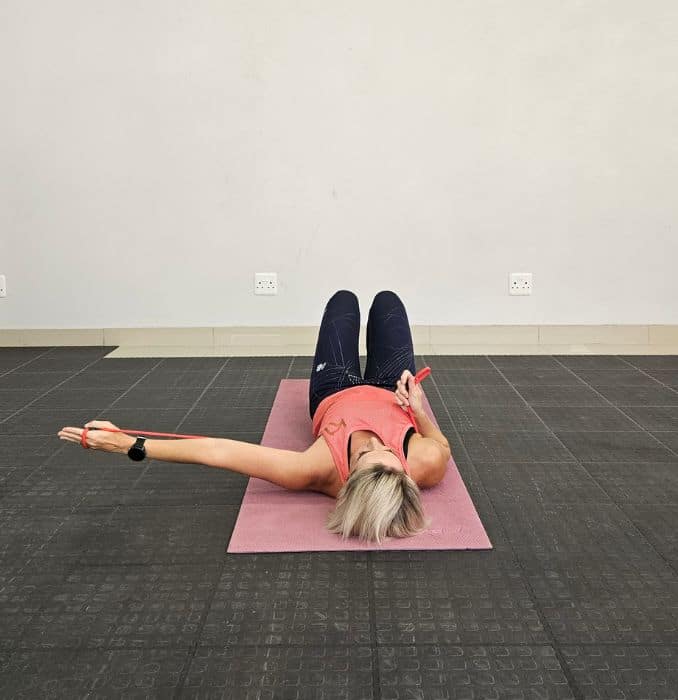 | 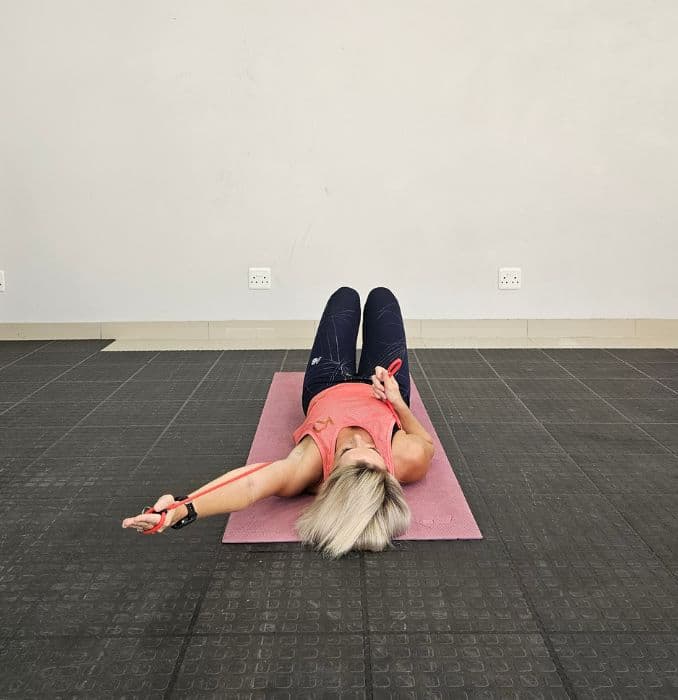 | 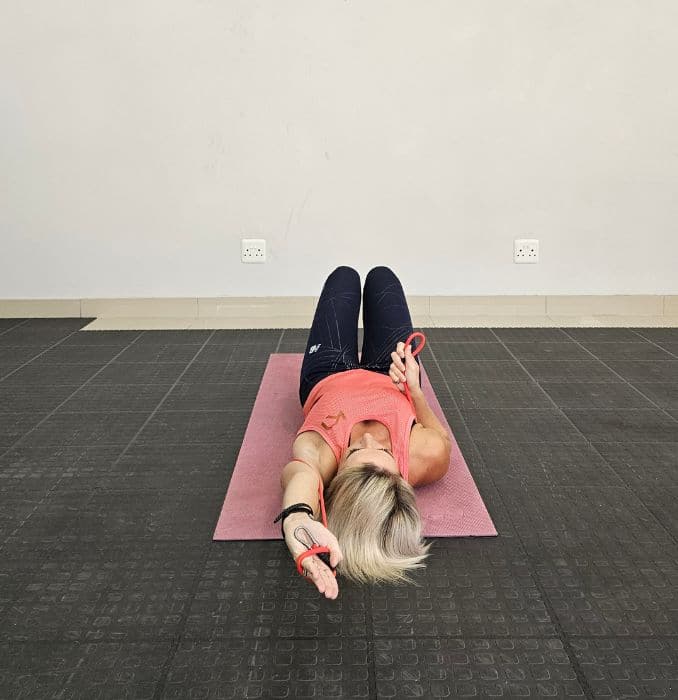 |
Pros:
- Targets and strengthens specific muscles of the upper back, promoting better posture and shoulder stability
- Can be performed with minimal equipment, making it accessible for many fitness levels
- Offers versatility with variations in grip and resistance levels, allowing for progressive overload
Cons:
- Requires proper form to avoid strain or injury, particularly in the shoulders and upper back
- May not provide a comprehensive upper body workout, as it primarily targets the upper back muscles
- Can be challenging for beginners or those with limited upper body strength, necessitating modifications or lighter resistance
5. Lying Twist
For this exercise, you can utilize an exercise band for added resistance.
Lie on your side on the floor with your knees bent together and your head supported with your lower arm, maintaining good alignment with your head, shoulders, and hips. Place the band underneath your armpits, holding the ends of the band on each thumb. Engage your core and extend your upper arm in front of your body at shoulder height. Then, swing your upper arm out to the side and hold the position for several repetitions. Slowly return to the starting position and repeat the movement as needed.
For an added challenge, you can deepen your stretch as you swing your upper arm out to the side.
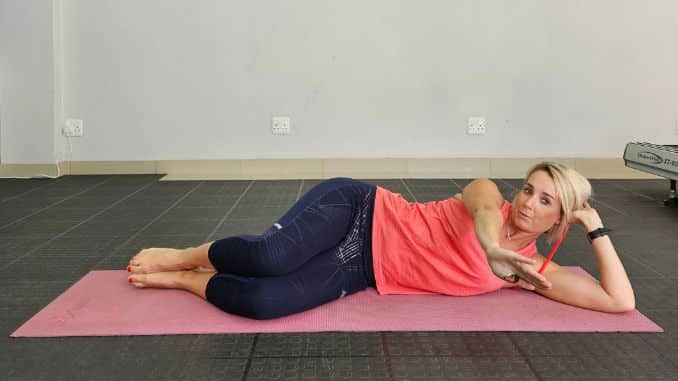 |
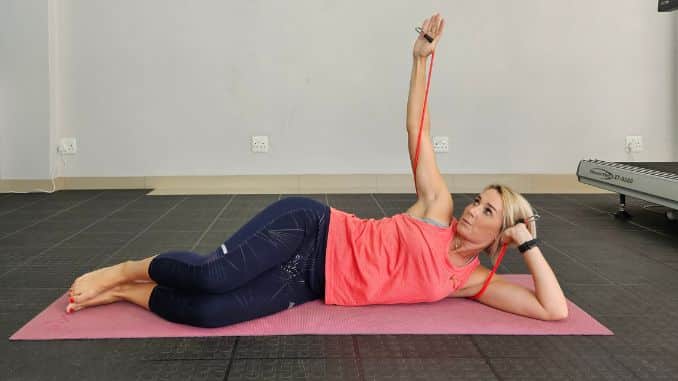 |
Pros:
- Increases flexibility in the spine, hips, and lower back
- Helps alleviate tension and tightness in the muscles surrounding the spine
- Can improve range of motion and mobility in the torso and hips
Cons:
- May strain the lower back if performed incorrectly or with excessive force
- Not suitable for individuals with existing back injuries or conditions
- Should be approached with caution by beginners or those with limited flexibility, as it can be challenging to maintain proper form.
Different Exercises For Shoulder Training
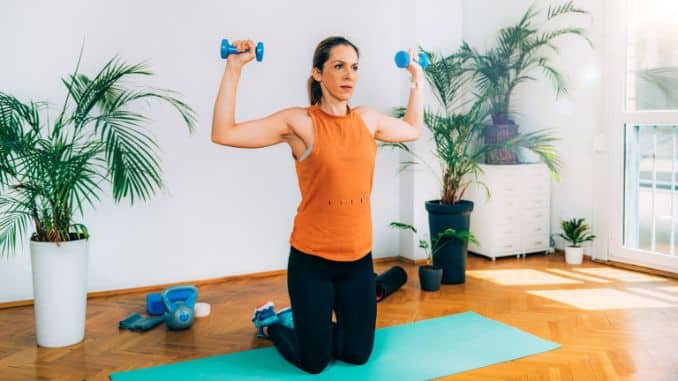
Here is an array of diverse exercises aimed at strengthening and toning the shoulders, employing a variety of equipment options:
Bodyweight Exercises:
Bodyweight exercises are strength-training exercises that use the body’s own weight for resistance. These exercises can be performed anywhere without the need for equipment, making them accessible for beginners and advanced fitness enthusiasts alike.
Examples are:
1. Shoulder Rolls
For this exercise, you need a lighter resistance band.
Begin in an upright standing position with your feet hip-width apart, maintaining good alignment with your head, shoulders, hips, and legs. Step on the center of the band with one foot, holding the ends of the band on each hand with an underhand grip. Engage your core and sweep both your arms straight up, above shoulder height. Return to the starting position and repeat the movement on the opposite side. Complete 10 repetitions.
 | 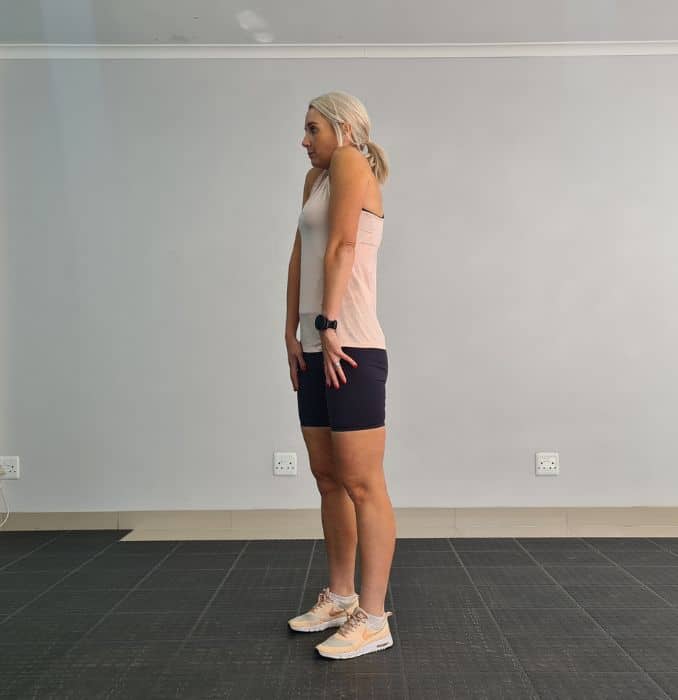 | 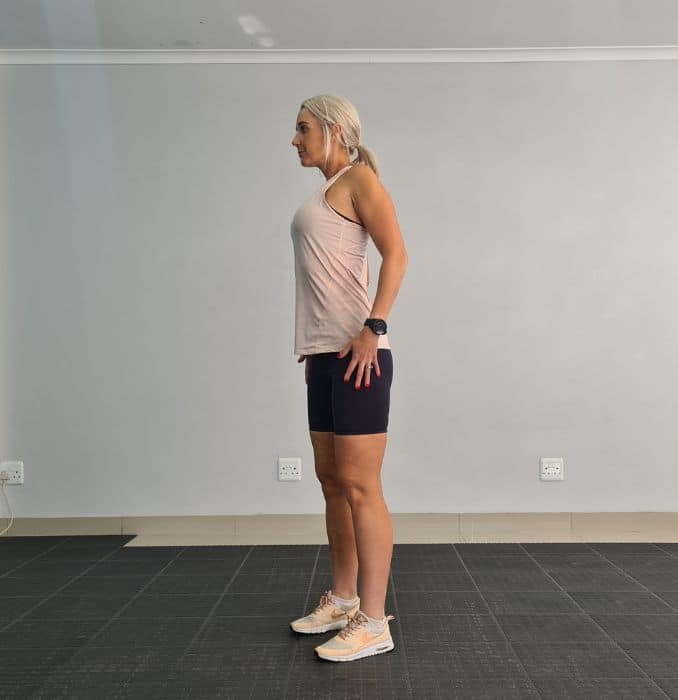 |
2. Shoulder Twist
Begin this shoulder workout routine in an upright standing position with your feet shoulder-width apart, maintaining good alignment with your head, shoulders, hips, and legs. Place your hands on your shoulders. Engage your core and twist your upper body to one side, keeping your hips forward. Return to the starting position and repeat the movement on the opposite side. Complete 10 repetitions.
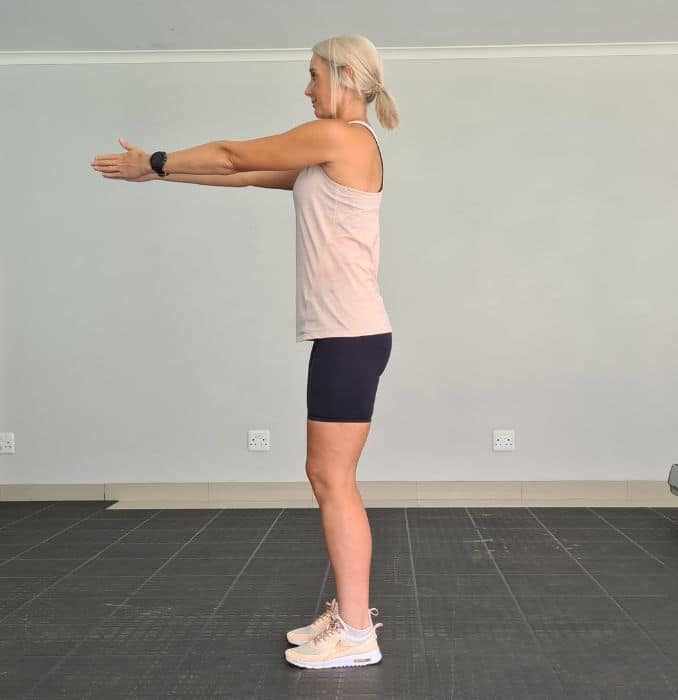 | 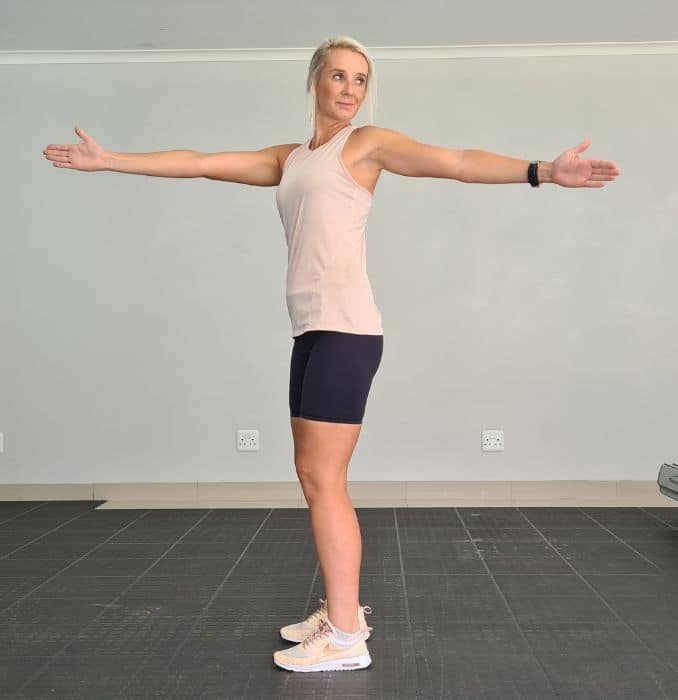 |
Dumbbell Exercises:
Dumbbell exercises, using handheld weights called dumbbells, are ideal for strengthening the shoulders.
Examples are:
1. Dumbbell Shoulder Press with Tricep Extension
For this dumbbell shoulder workout, you need a light dumbbell or a can of soup for this exercise.
Begin upright with your feet hip-width apart, maintaining good alignment with your head, shoulders, hips, and legs. Hold a dumbbell in each hand at shoulder height with your palms facing upward. Engage your core, bend your elbows to the side, and press your arms overhead. Then, hinge your hips and slightly bend your upper body in front, bringing your arms down at shoulder height, then stretching your arms backward. Pull back up, returning to the starting position. Repeat the sequence of movements starting with 3 sets of 10 to 15 repetitions.
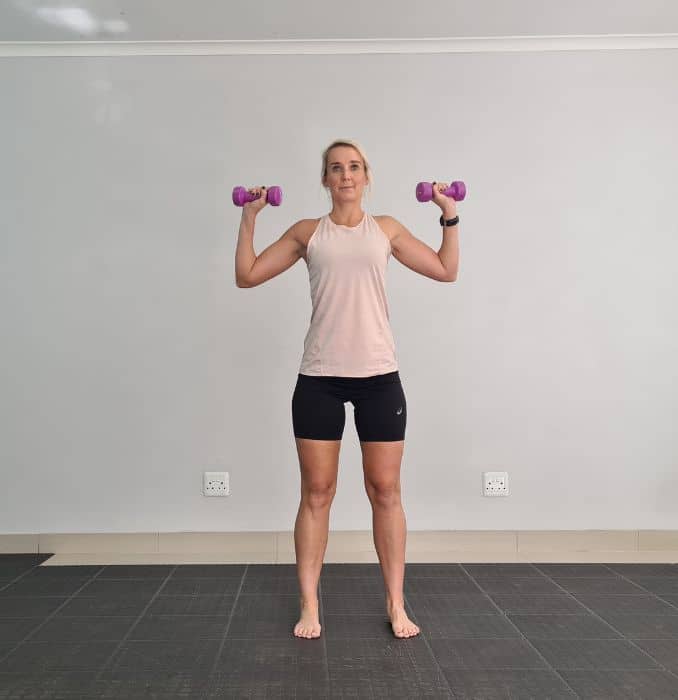 | 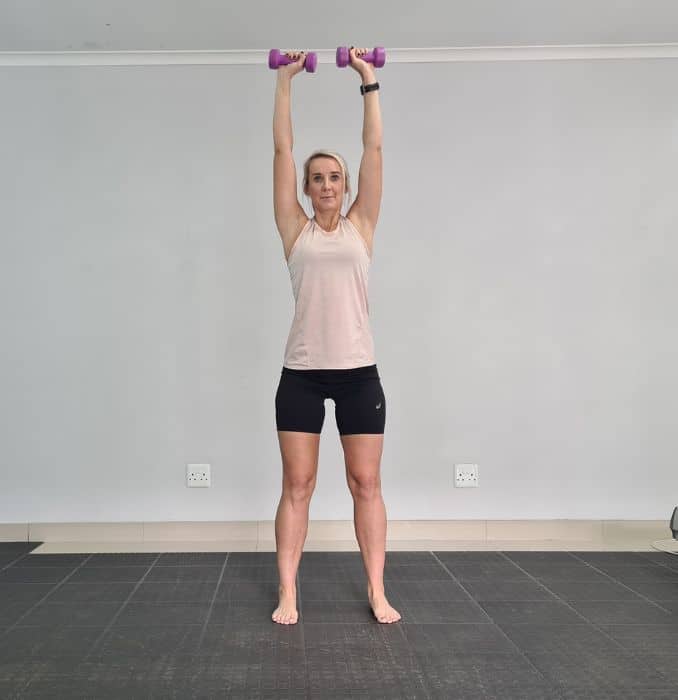 | 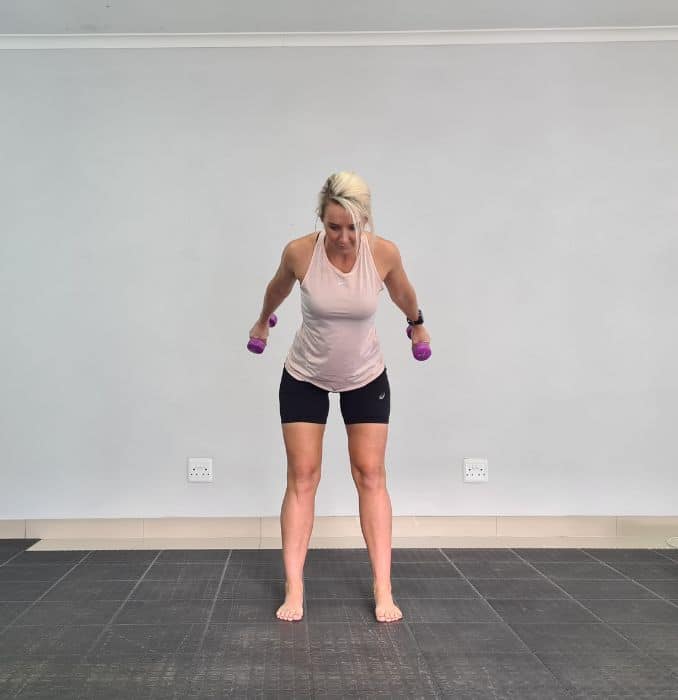 |
2. Lateral Arm Raise
For this exercise, you can use a dumbbell or a can of soup.
Begin in an upright standing position with your feet hip-width apart, maintaining good alignment with your head, shoulders, hips, and legs. Then, hold a small dumbbell on each hand with your palm facing inward. Place your arms at your sides and engage your core. Raise both arms straight to the side at shoulder height. Lower your arms to return to the starting position and repeat the movement. Complete 10 repetitions.
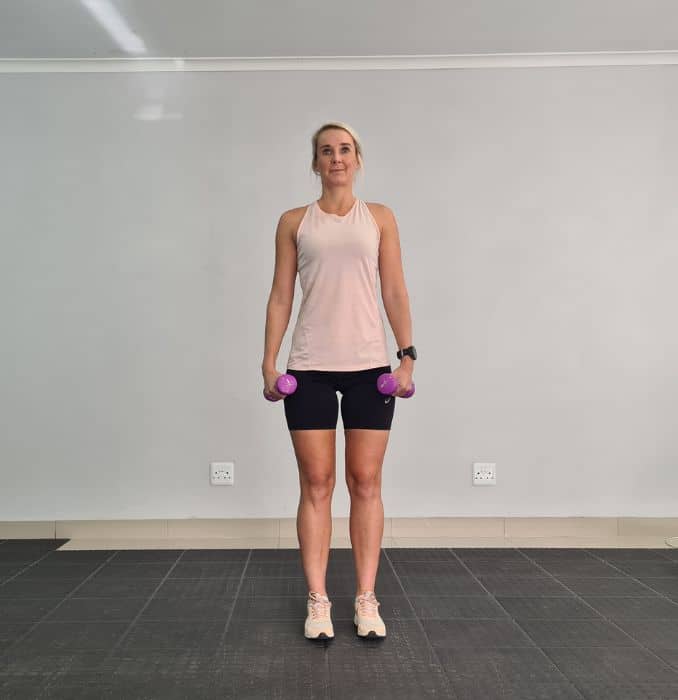 | 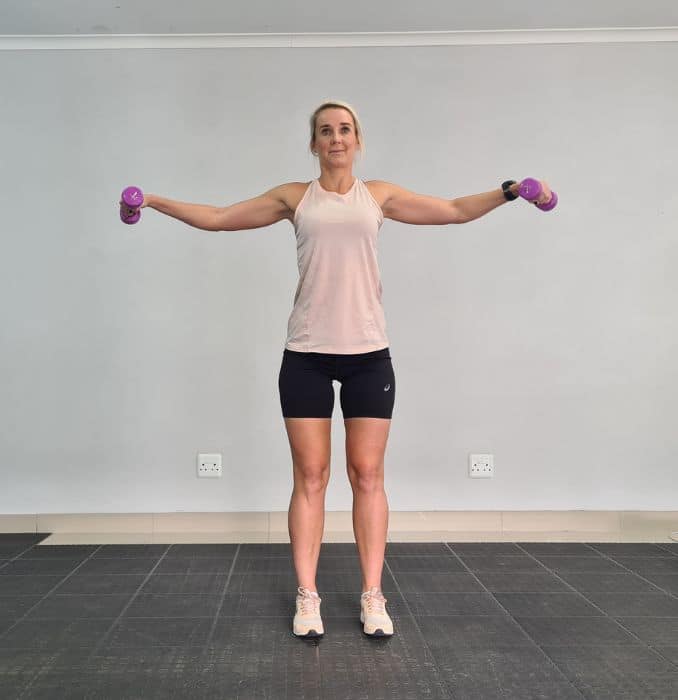 |
Resistance Band Exercises:
Resistance band exercises utilize elastic bands of varying resistance levels to provide resistance during workouts. These bands can be anchored to stable objects or used in hand-held exercises to target muscles and improve strength, flexibility, and mobility.
1. Shoulder Sweep
For this exercise, you need a lighter resistance band.
Begin upright with your feet hip-width apart, maintaining good alignment with your head, shoulders, hips, and legs. Step on the center of the band with one foot, holding the ends of the band on each hand with an underhand grip. Engage your core and sweep both your arms straight up, above shoulder height. Return to the starting position and repeat the movement on the opposite side. Complete 10 repetitions.
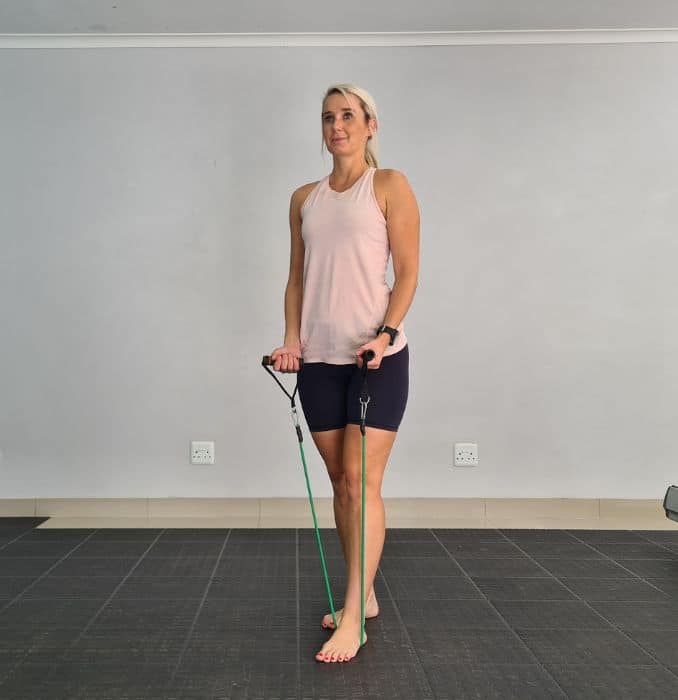 |  |
2. Bend Over Rows
Begin this shoulder workout routine in an upright standing position with your feet hip-width apart, maintaining good alignment with your head, shoulders, hips, and legs. Step your one foot on the center of the resistance tubing and hold the ends of the tubing in each hand. With a slight bend of your front knee, hinge through your hips, keeping your other leg straight. Engage your core and pull both arms up in a rowing motion, keeping your elbows 30 to 45 degrees away from your body. Return to the starting position and repeat the movement on the opposite foot. Start with 3 sets of 15 repetitions on each side.
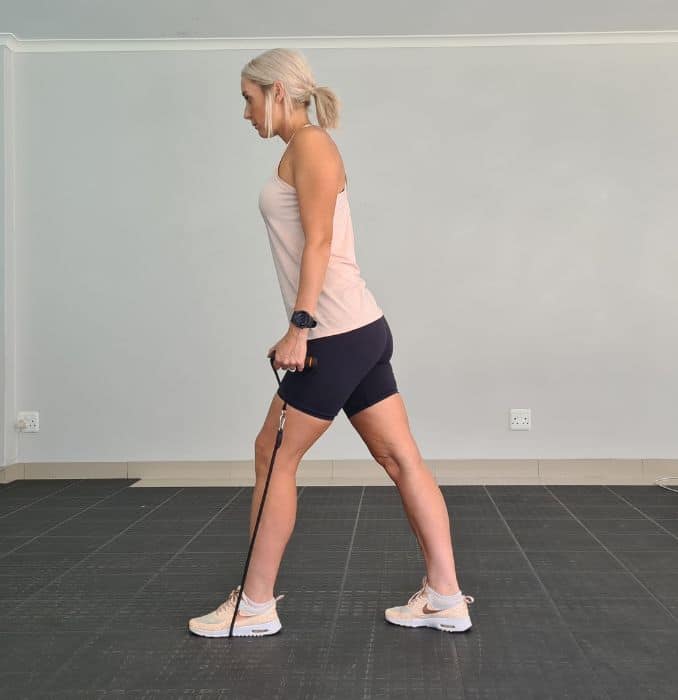 | 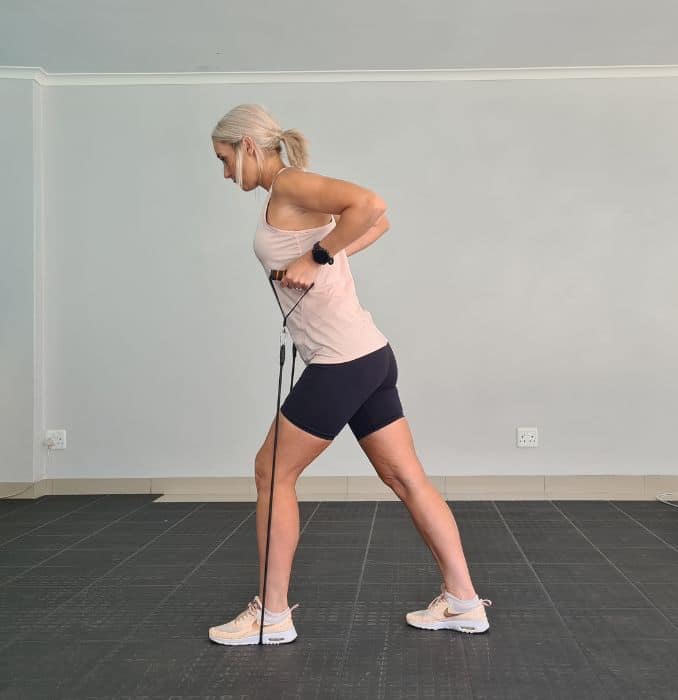 |
Each of these workout items offers unique benefits and can be incorporated into a well-rounded fitness routine to target different muscle groups and achieve various fitness goals.
Final Thoughts
A well-designed shoulder workout routine is crucial for sculpting strong and defined shoulder muscles. Targeted exercises with proper form and progressive resistance help achieve optimal results while minimizing the risk of injury. Personalizing the routine, incorporating warm-ups, and seeking professional guidance contribute to a safe and effective approach for sculpted shoulders, enhancing both aesthetics and overall strength.
Don’t let shoulder pain hold you back! Check out our “Shoulder Pain Solved” program for a comprehensive approach to finding relief and improving your shoulder health. Say goodbye to pain and hello to a stronger, more mobile you!




